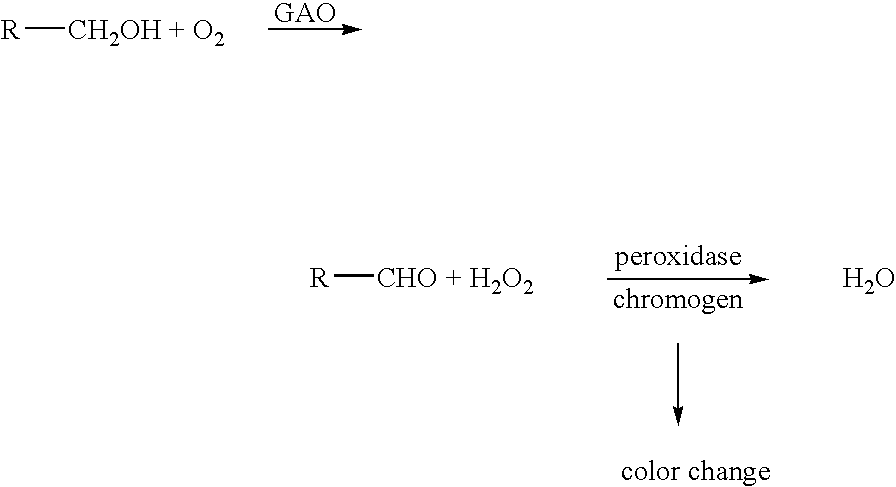Directed evolution of oxidase enzymes
a technology of oxidase enzymes and enzymes, applied in the field of directed evolution of oxidase enzymes, can solve the problems of less than optimally efficient enzyme evolution, and achieve the effects of improving expression, thermostability and/or activity, and high expression
- Summary
- Abstract
- Description
- Claims
- Application Information
AI Technical Summary
Benefits of technology
Problems solved by technology
Method used
Image
Examples
example 1
Activity Assays for Galactose Oxidase Expressed in E. coli
[0113]This Example describes assays used for evaluating galactose oxidase activity. Galactose oxidase generates equimolar amounts of hydrogen peroxide by oxidation of a substrate. Colorimetric detection of hydrogen peroxide was therefore used to assay galactose oxidase activity, employing the following reaction scheme:
[0114]
[0115]This system can be used to assay for oxidation of various substrates, with a very high sensitivity. In the reaction scheme above, an alcohol group of a substrate R is oxidized to produce an aldehyde and hydrogen peroxide (H2O2) is released. For example, D-galactose is converted to D-galactohexodialdose plus H2O2. The chromogen, in the presence of hydrogen peroxide and peroxidase enzyme, e.g. horseradish peroxidase (HRP), produces a detectable color change, indicating that the reaction catalyzed by GAO has occurred.
[0117]The activity of galactose oxidase produced in E. coli wa...
example 2
Construction of Galactose Oxidase Plasmids
[0152]Plasmids were constructed to express galactose oxidase gene (gao) from Fusarium ssp. as described below. Several vectors were examined for high expression. Plasmids with different promoters and different sequences between the GAO gene and the ribosime binding site were constructed, as described. Escherichia coli strain BL21(DE3) and KY-14478 were transformed with these plasmids. Permable cells from test tube cultures were used for the assay.
[0153]A. Construction of Plasmids
[0154]1. Modified pUC18 Vector Plasmids
[0155]Modified pUC18 plasmids were made to be used for constructing galactose oxidase expression plasmids. As shown in FIG. 7, vector pUC18 was digested with the restriction enzyme HindIII, blunted with T4 DNA polymerase and ligated with T4 DNA ligase to create vector pUC 18-HL lacking the HindIII site. pUC 18-HL was digested with EcoRI, blunted with T4 DNA polymerase and ligated with T4 DNA ligase to create vector pUC18-EHL lac...
example 3
Optimization of error-prone PCR conditions
[0186]A. General PCR Conditions
[0187]Mutation of the galactose oxidase gene (gao) was induced by error-prone PCR and according to known techniques (66, 129–133, 136–139). Wild type gao on pGAO-027 was replaced by the PCR products which were mutant galactose oxidase genes. The resultant plasmids were named as pGAO-027M. E. coli BL21(DE3) was transformed with these plasmids. Almost all transformants carrying error prone PCR products instead of wild type gao lost their galactose oxidase activities (FIG. 7). Mutations were induced on the whole galactose oxidase gene by error-prone PCR, using conditions “A” of TABLE 3.228 clones were selected randomly from each set of conditions with different manganese concentrations. These clones were cultivated and assayed with micro-plates. More than 65% of transformants lost their galactose oxidase activity, even though manganese ions were not added to the PCR solution.
[0188]Various reaction conditions for e...
PUM
| Property | Measurement | Unit |
|---|---|---|
| molecular mass | aaaaa | aaaaa |
| pH | aaaaa | aaaaa |
| depth | aaaaa | aaaaa |
Abstract
Description
Claims
Application Information
 Login to View More
Login to View More - R&D
- Intellectual Property
- Life Sciences
- Materials
- Tech Scout
- Unparalleled Data Quality
- Higher Quality Content
- 60% Fewer Hallucinations
Browse by: Latest US Patents, China's latest patents, Technical Efficacy Thesaurus, Application Domain, Technology Topic, Popular Technical Reports.
© 2025 PatSnap. All rights reserved.Legal|Privacy policy|Modern Slavery Act Transparency Statement|Sitemap|About US| Contact US: help@patsnap.com



